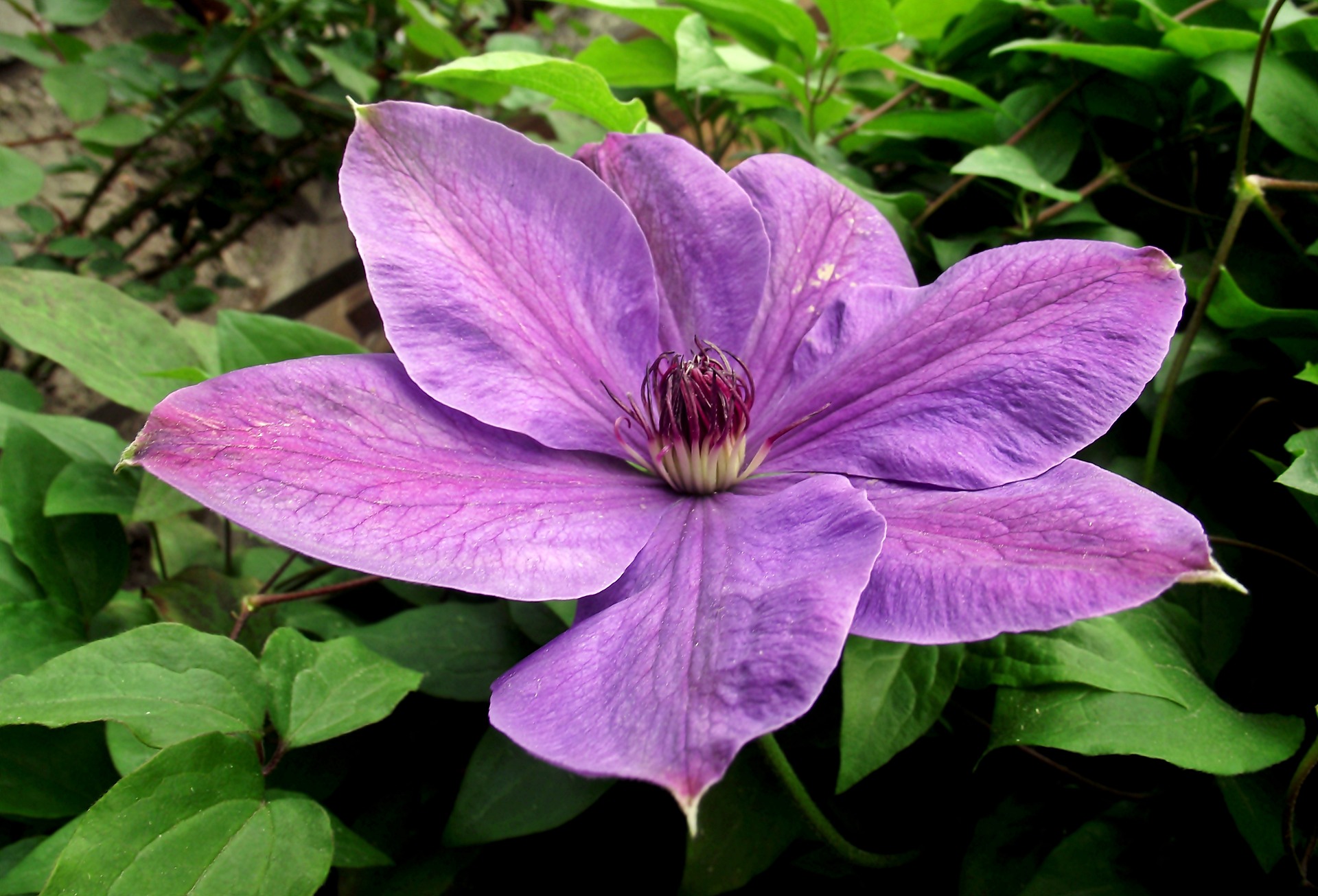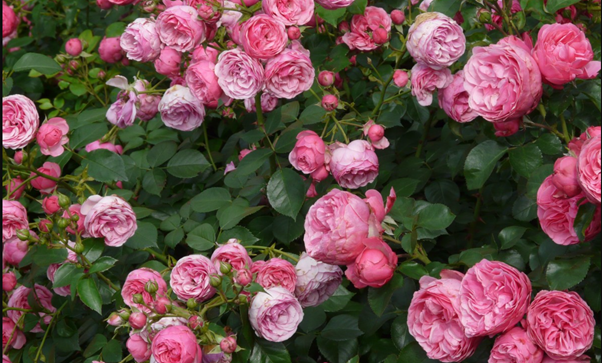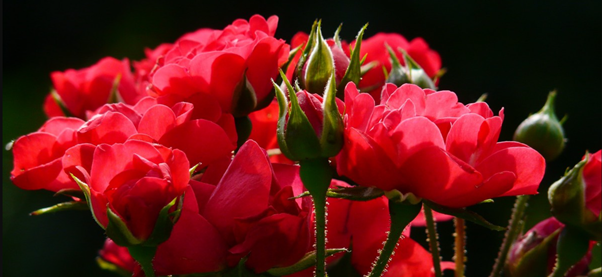Why Grow Clematis
Clematis plant are some of the most versatile blooms that you can grow in a garden.
Because they are climbers you can pretty much grow them anywhere as long as they have something to cling onto. This could be:
- A trellis or wall panel
- An obelisk, wigwam or climbing frame
- Another plant
They take up almost zero ground space but will need room for the stems to grow and flourish. They are also one of the most satisfying plants to grow, beautiful blooms in a myriad of shapes sizes and colours which just add that wow factor to your garden.

Types of Clematis
Clematis is a large group of plants which belong to the Ranunculaceae family. There are over 300 species and hundreds of hybrids. For the average gardener, Clematis varieties can be divided into eight separate groups. These in turn are organised into two main divisions, the Large Flowering and Small Flowering species.
Large Flowering Clematis
These varieties are typically characterized their large, dramatic flowers, which are sadly, rarely scented. The roots of these plants are lace-like in appearance.
These Clematis plants are unfortunately prone to the fungal disease known as wilt.
Early Large-Flowered Group

- The flowers of this group are incredibly large, often 15-25 cm (6-10 in) across. These are star-shaped and may be single or semi-double blooms
- Flowers come in a wide variety of colours, usually bloom in two waves initially late spring or early summer, then likely repeat flower in late summer and early autumn
- Pruning Group 2
- Notable Varieties
- Clematis ‘Diamantina’
- Clematis ‘Nelly Moser’
- Clematis ‘The President’
Late Large-Flowered Group

- Their flowers are impressively large, 13-20 cm (5-8 in) across usually star-shaped, in single, semi-double or double blooms
- These clematis can reach up to 2-3.5 m (6-12 ft) in height
- They usually bloom in two waves, early and mid summer on new wood, often repeat flowering again in late summer and early autumn
- They are usually full sun or partial shade tolerant
- The foliage of some of these clematis is susceptible to powdery mildew
- Pruning group 3.
- Notable varieties
- Clematis ‘Ernest Markham’
- Clematis ‘Perle d’Azure’
- Clematis ‘Ville de Lyon’
Small Flowering Clematis
Small flowered Clematis are usually characterized an abundance of small flowers, which are often scented. The roots of the plant are fibrous in appearance. These plants are easy to grow and the foliage rarely suffers from wilt.
This main Clematis group is subdivided into six distinctive sub-groups each presenting very different sets of qualities.
Atragene Group
- This group of clematis contain varieties that are extremely hardy, undemanding and easy to grow
- They’re also cold-hardy so can be grown on north and east facing walls
- Profuse bloomers from mid to late spring and occasionally in late summer
- The flowers produce ornamental, fluffy and silky seed-heads, which remain on the plant, adding further interest
- They are gentle plants and do not smother their supporters
- Pruning Group 1
- Notable varities
- Clematis ‘Pamela Jackson’
- Clematis ‘Frankie’
- Clematis ‘Markham’s Pink’
Clematis – Evergreen Group

- The earliest Clematis to flower, the Evergreen group includes small-flowering clematis which provide gardeners with floral interest in winter
- Blooming from midwinter onward lowering at a time when the garden has little to offer
- Transform boundary walls and fences into leafy screens, the evergreen foliage remains handsome all year-round and providing multi-season interest
- Pruning Group 1
- Notable varities
- Clematis ‘Apple Blossom’
- Clematis cirrhosa var. balaerica
Herbaceous (or Integrifolia) Group

- This group contains easy to grow and long lived plants, these clamber over other plants in the border
- They have no twining leaves (petioles) to help them climb and die to the ground at the end of each year
- They bloom profusely over a long season, from early summer to early autumn, with the bonus of attractive foliage
- Deadhead them after their first flush of blooms, they will bloom again within 30-45 days. You may enjoy 2 or 3 waves of colourful blooms
- Pruning Group 3
- Notable varieties
- Clematis ‘Arabella’
- Clematis x durandii
- Clematis ‘Juuli’
Clematis – Montana Group

- The Montana group of clematis are the most vigorous of clematis varieties
- Their flowers are but they are full of charm, fragrant and create an abundant and spectacular floral display
- Strong growers, they’re great for arbors, trellises, pergolas and other garden structures. These need to be sturdy as these plants can get very big
- Pruning Group 1
- Notable varieties
- Clematis ‘Elizabeth’
- Clematis montana var. grandiflora
- Clematis montana var. rubens
Clematis – Orientalis Group

- Originating from central Europe and Asia, this group comprises of species with bright yellow lantern or star-shaped flowers that are often nodding.
- They bloom profusely from mid to late summer, even into late autumn.
- Once the floral display is over the flowers are replaced with showy pom-pom like seed-heads.
- Pruning Group 3
- Notable varieties
- Clematis ‘Bill MacKenzie’
- Clematis serratifolia
- Clematis tangutica
Clematis – Viticella Group

- This group of clematis originates from Southern Europe and produces varieties that are durable, easy-care, vigorous and free-flowering
- They bloom profusely over a long period extending from midsummer to autumn
- They can be grown in large containers if give enough room enough to grow and something to climb on
- Pruning Group 3
- Notable varieties
- Clematis ‘Etoile Violette’
- Clematis ‘Polish Spirit’
- Clematis ‘Princess Diana’
Planting
It’s best to plant in early spring or mid autumn as it is warm and the soil is moist. This helps to establish good root development for your plant.
Avoid planting in waterlogged, frozen or drought inflicted soil.
Choosing a clematis
You are likely to purchase a clematis from a garden centre, nursery or even a supermarket. Always look for plants that have healthy foliage, a multitude of stems and have a good number of flower buds on them. I generally avoid plants that are already full of flower as you are likely to damage them when planting the specimen.
These plants are quite delicate, keep them securely fastened in your car when taking them home.
Preparing the site
- Most clematis will comfortably grow in sun or partial shade, but avoid a very shady spot. Herbaceous varieties need to be in full sun.
- Some varieties which include evergreen winter and spring-flowering specimens will need a sheltered spot.
- Clematis need to keep their roots cool and moist, consider this when you work out your planting area.
- Allow enough space for your plant to grow into as some clematis are very vigorous.
- Herbaceous clematis are best grown through plant supports or into nearby shrubs
- Climbing varieties will need something to cling onto such as a trellis, arbour, obelisk or panel.
Preparing the Plant
Before you plan the clematis, soak the root-ball in water for 30 minutes before you plant it.

Clematis are tolerant of most soil types but if you have sandy or clay soils dig in some organic matter to help improve the soils structure. Dig a hole twice as wide as the root-ball but depth will vary depending on the clematis type chosen.
If planting against a wall or fence, dig the planting hole so that the root-ball will sit around 20 to 30cm (8 to 12in) away from the wall, further out if there is an overhanging. Use a bamboo cane to help the plant reach its permanent support.
For large-flowered hybrid cultivars (early and late-summer-flowering) make sure the top of the root-ball is 5-7.5cm (2-3in) below the soil surface. This encourages new shoots to grow from below ground level, it also helps the plant to recover from Clematis wilt.
Plant all other clematis types with the root-ball just below the soil surface.
Clematis love to gave their heads in the sun and their feet in the shade
Try and plant the roots in a shady area if possible, if not add stones around the roots to protect them from the heat.
Clematis bought from garden centres come pre-attached to bamboo canes and secured by plastic ties. These will need to be very carefully removed before attaching the vine to its support.

Most Clematis (with the exception of Herbaceous varieties) will naturally attach themselves to their supports with their twining leaves (petioles). You can also tie the stems to their supports but be careful not to damage the delicate stems. I usually create a loose loop with garden wire to support the stem without squashing it.
Pruning
There’s an old saying regarding clematis:
“If it flowers before June, don’t prune”
The above quote is a really good guide if you are unsure of your clematis type.
- If it flowers before early summer (June), leave it alone.
- If it flowers from late June onwards, prune the plant in late February.

If you do know your Clematis type then you can find out which of the following three pruning groups it fits in.
Group 1
- Officially these clematis shouldn’t need pruning however, as the plants get bigger they become more unwieldy
- Regular pruning of clematis encourages strong growth and flowering and keeps the plant in check otherwise they become mass of tangled stems.
- Prune your plants after they have flowered cutting back by up to one third. Always remember to cut to a healthy pair of buds.
Group 2
- Prune in late winter or early spring (February)
- Removing dead or weak stems before growth begins. Check each stems from the top down until you reach a pair of healthy buds, and cut just above them.
- Avoid heavy pruning otherwise flowers may be lost
- To encourage a second flush of flowers, prune back some stems by cutting to large buds or a strong side shoot immediately below the blooms.
Group 3
- In February or March, cut back all the old stems to the lowest pair of healthy buds 15-30cm (6in-1ft) above soil level
- If left unpruned, this group continues to grow and becomes top heavy
- If you have space, leave the plant to scramble over pergolas or walls
- Note: Herbaceous Clematis can be cut back to near ground level
Diseases
Clematis Wilt
- Clematis wilt is a fungal disease of clematis which mostly affects the large-flowered hybrid cultivars. The fungus causes rapid wilting and, in severe cases, can kill the whole plant
- Leaves will have discoloured black spots and show marked drooping
- If the wilting stems are carefully removed and cut back to a set of healthy leaves the plant will survive. Be careful to dispose of the diseased stems as these can infect other plants
Clematis Slime Flux
- This is a nasty disease. Where Clematis wilt usually affects the odd stem, Slime flux will affect the whole plant.
- The disease is characterised by a horrible slimy, crusty, smelly ooze coming from the stems
- It is likely to be fatal to the plant, but it can be saved if you cut away all the stems affected by the infestation. If you are lucky new shoots will appear in the un-affected areas.
Feeding and Watering
- Clematis are thirsty plants, they don’t like to dry out and can become prone to drought stress.
- In hot spells keep them regularly watered – especially if they are in a container
- Feed them with a Potassium rich fertiliser, a rose fertiliser, for example, is very good
- Apply a layer of Mulch after feeding such as well-rotted manure, leaf mould or garden compost, to improve the soil and help conserve moisture
- Feed container-grown clematis monthly during the spring and summer using a general-purpose liquid fertiliser.

















Recent Comments